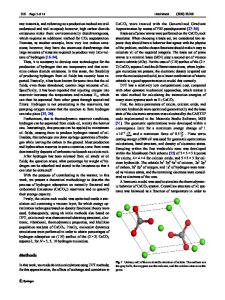Simulation of hydrogen storage in porous carbons
- PDF / 1,003,416 Bytes
- 16 Pages / 584.957 x 782.986 pts Page_size
- 80 Downloads / 427 Views
e is the main problem to use hydrogen as a fuel in the car industry. Porous carbons are promising storage materials. We have performed computer simulations to investigate carbidederived porous carbons, showing that these materials exhibit a structure of connected pores with graphitic walls. We then apply a thermodynamic model to evaluate the hydrogen storage. The model accounts for the quantum effects of the motion of the molecules in the pores. The pore widths optimizing the storage depend on pore shape, temperature, and pressure. At 300 K and 10 MPa, the optimal widths lie in the range 6–10 Å. The predictions are consistent with experiment. The calculated storage capacities fall below the targets proposed by the U.S. Department of Energy. This is a consequence of the weak interaction between hydrogen and the pore walls. Metallic doping enhances the binding energy of hydrogen to the walls, which has promising consequences for hydrogen storage.
I. INTRODUCTION
The burning of fossil fuels contributes to the pollution of the environment and to the global warming. Besides, petrol will be exhausted in a few decades. Many efforts are now dedicated to find clean fuels that could replace gasoline in transportation vehicles, and hydrogen is considered as a firm candidate.1 Those cars will use an electric motor based on a hydrogen fuel cell.2 The hydrogen gas coming from the storage tank reacts in the cell with atmospheric oxygen producing an electric current, and the only emission from the reaction is pure water. The hydrogen cars will have some advantages with respect to gasoline cars and cars moved by electric batteries. Hydrogen is very abundant and can be produced from water by electrolysis. The recharge times will be substantially smaller than the recharge times for electric battery cars. In addition, the technology of hydrogen fuel cells is well developed.2 The energy content per mass of hydrogen, 120 MJ/kg, is higher than that of gasoline, 44 MJ/kg. However, hydrogen is a gas, and its energy content per volume at room conditions, 0.01 MJ/L, is much smaller than that of gasoline, 35 MJ/L. In gaseous hydrogen, at normal conditions of pressure and temperature, the average distance between molecules is about 3.3 nm, and 1 kg of hydrogen occupies the volume of a soccer goal. Therefore, the bottleneck of a)
Address all correspondence to this author. e-mail: [email protected] This paper has been selected as an Invited Feature Paper. DOI: 10.1557/jmr.2012.370 J. Mater. Res., Vol. 28, No. 4, Feb 28, 2013
http://journals.cambridge.org
Downloaded: 30 May 2014
the hydrogen car technology is to find an efficient way to store hydrogen. In other words, the problem is how to store in a small tank 5 kg of hydrogen to run the car for about 600 km. The short-term targets proposed by the U.S. Department of Energy (DOE) in September 2009, which would permit using hydrogen as a fuel in onboard applications, are: a gravimetric storage capacity of at least 5.5% of hydrogen in weight and a volumetric capacity of more than 0.040 kg of hydr
Data Loading...











